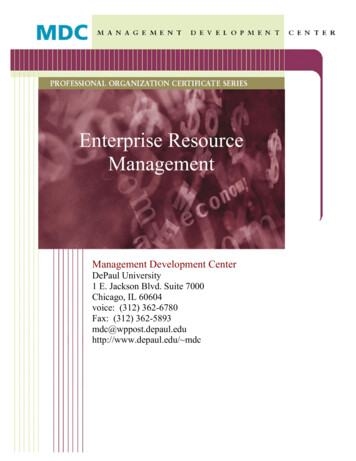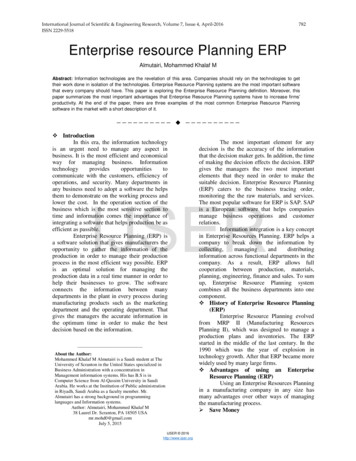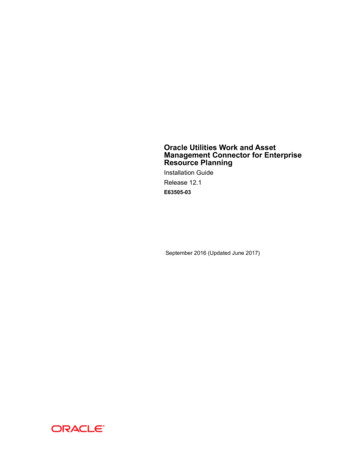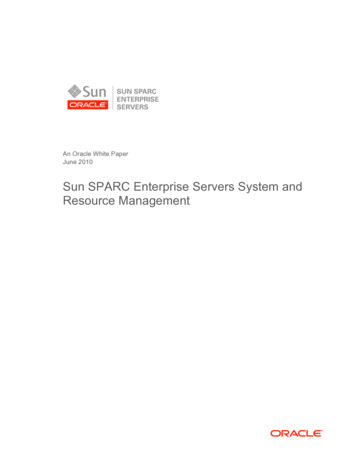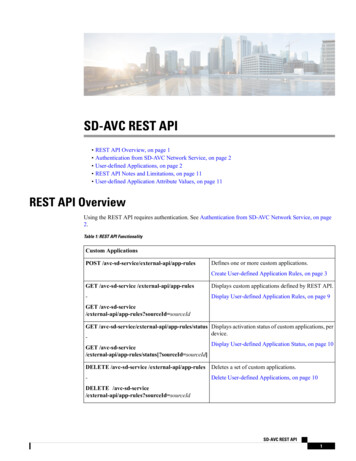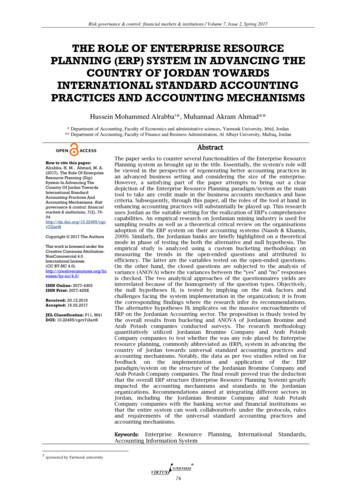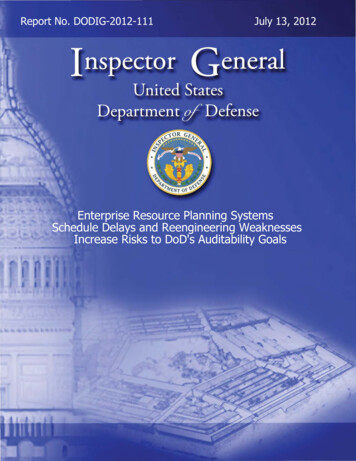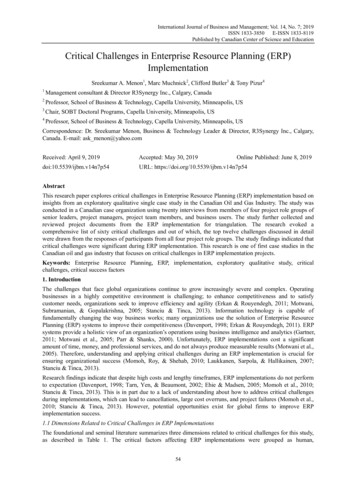
Transcription
International Journal of Business and Management; Vol. 14, No. 7; 2019ISSN 1833-3850E-ISSN 1833-8119Published by Canadian Center of Science and EducationCritical Challenges in Enterprise Resource Planning (ERP)ImplementationSreekumar A. Menon1, Marc Muchnick2, Clifford Butler3 & Tony Pizur41Management consultant & Director R3Synergy Inc., Calgary, Canada2Professor, School of Business & Technology, Capella University, Minneapolis, US3Chair, SOBT Doctoral Programs, Capella University, Minneapolis, US4Professor, School of Business & Technology, Capella University, Minneapolis, USCorrespondence: Dr. Sreekumar Menon, Business & Technology Leader & Director, R3Synergy Inc., Calgary,Canada. E-mail: ask menon@yahoo.comReceived: April 9, 2019Accepted: May 30, 2019Online Published: June 8, 2019doi:10.5539/ijbm.v14n7p54URL: https://doi.org/10.5539/ijbm.v14n7p54AbstractThis research paper explores critical challenges in Enterprise Resource Planning (ERP) implementation based oninsights from an exploratory qualitative single case study in the Canadian Oil and Gas Industry. The study wasconducted in a Canadian case organization using twenty interviews from members of four project role groups ofsenior leaders, project managers, project team members, and business users. The study further collected andreviewed project documents from the ERP implementation for triangulation. The research evoked acomprehensive list of sixty critical challenges and out of which, the top twelve challenges discussed in detailwere drawn from the responses of participants from all four project role groups. The study findings indicated thatcritical challenges were significant during ERP implementation. This research is one of first case studies in theCanadian oil and gas industry that focuses on critical challenges in ERP implementation projects.Keywords: Enterprise Resource Planning, ERP, implementation, exploratory qualitative study, criticalchallenges, critical success factors1. IntroductionThe challenges that face global organizations continue to grow increasingly severe and complex. Operatingbusinesses in a highly competitive environment is challenging; to enhance competitiveness and to satisfycustomer needs, organizations seek to improve efficiency and agility (Erkan & Rouyendegh, 2011; Motwani,Subramanian, & Gopalakrishna, 2005; Stanciu & Tinca, 2013). Information technology is capable offundamentally changing the way business works; many organizations use the solution of Enterprise ResourcePlanning (ERP) systems to improve their competitiveness (Davenport, 1998; Erkan & Rouyendegh, 2011). ERPsystems provide a holistic view of an organization’s operations using business intelligence and analytics (Gartner,2011; Motwani et al., 2005; Parr & Shanks, 2000). Unfortunately, ERP implementations cost a significantamount of time, money, and professional services, and do not always produce measurable results (Motwani et al.,2005). Therefore, understanding and applying critical challenges during an ERP implementation is crucial forensuring organizational success (Momoh, Roy, & Shehab, 2010; Laukkanen, Sarpola, & Hallikainen, 2007;Stanciu & Tinca, 2013).Research findings indicate that despite high costs and lengthy timeframes, ERP implementations do not performto expectation (Davenport, 1998; Tarn, Yen, & Beaumont, 2002; Ehie & Madsen, 2005; Momoh et al., 2010;Stanciu & Tinca, 2013). This is in part due to a lack of understanding about how to address critical challengesduring implementations, which can lead to cancellations, large cost overruns, and project failures (Momoh et al.,2010; Stanciu & Tinca, 2013). However, potential opportunities exist for global firms to improve ERPimplementation success.1.1 Dimensions Related to Critical Challenges in ERP ImplementationsThe foundational and seminal literature summarizes three dimensions related to critical challenges for this study,as described in Table 1. The critical factors affecting ERP implementations were grouped as human,54
ijbm.ccsenet.orgInternational Journal of Business and ManagementVol. 14, No. 7; 2019technological, and organizational dimensions, also detailed in Table 1. (Sumner, 2000; Themistocleus et al. 2001;Ehie & Madsen, 2005; Momoh et al., 2010; Stanciu & Tinca, 2013).Table 1. Critical Challenges in ERP implementation as found in the literatureDimensionsCritical challengesFindingsSumnerThemistoEhiecleus etMadsen&Momoh etStanciu &al.TincaalTechnologicalExcessive customizationOrganizationalDilemma of internal integrationXXXOrganizationalPoor understanding of business implications andXHumanLack of change managementXTechnologicalPoor Data QualityXOrganizationalMisalignment of IT with the businessXOrganizationalHidden costsHumanLack of senior management supportXOrganizationalFailure to redesign business processes to fit theXHumanInsufficient training and reskilling / Limited TrainingXHumanLack of ability to recruit and retain qualified ERPXrequirementsXXXXXXXsoftwaresystem developersHumanInsufficient training of commitmentofX'customers' to project activities and managementOrganizationalLack of integrationXOrganizationalLack of a proper management structureXXHumanInsufficient internal expertiseXHumanLack of a championXHumanLack of business analystsXHumanFailure to mix internal and external personnelXTechnologicalFailure to emphasize reporting, including customXHumanInsufficient discipline and standardizationXHumanIneffective communicationsXTechnologicalAvoid technological bottlenecksXOrganizationalERP vendor selectionHumanInternal implementation teamXHumanProject oppositionXHumanuser trainingOrganizationalProject management principlesTechnologicalFeasibility/evaluation of ERP projectXHumanHuman resource developmentXOrganizationalProcess re-engineeringXTechnologicalIT infrastructureXHumanConsulting services /Client consultationXreport developmentXXXHumanEmployees resistance to changeHumanConflicts with ConsultantsXXHumanInternal ConflictsXHumanConflicts with VendorsXOrganizationalConflicts with business strategyXNote. The list is based on the research findings from foundational literature (Sumner, 2000; Themistocleus et al., 2001; Ehie & Madsen, 2005;Momoh, Roy, & Shehab, 2010; Stanciu & Tinca, 2013).55
ijbm.ccsenet.orgInternational Journal of Business and ManagementVol. 14, No. 7; 20191.2 Critical Success Factors in ERPRockart (1979) was the first author to apply the critical success factor approach in the information systems area.The CSF method helped organizations to specify their own critical information needs. Rockart (1979) definedcritical success factors as the limited number of areas in which results, if satisfactory, will ensure theorganization’s successful competitive performance (Esteves & Pastor, 2001). Researchers of seminal and recentstudies have identified several success factors, which are outlined in Table 2.Table 2. Critical success factors in ERP implementationResearch StudyCritical Success FactorsHolland and LightStrategic: legacy systems, business vision, ERP strategy, top management support, project scheduling and planning. Tactical:(1999)client consultation, software configuration, client acceptance, monitoring and feedback, communication, troubleshooting.Parr and ShanksManagement support, best people full-time, empowered decision-makers, deliverable dates, champion, vanilla ERP, smaller(2000)scope, definition of scope and goal, balanced team, commitment.Nah,Lau,andTop management support; business plan and vision; business process re-engineering with minimum customization; projectmanagement; monitoring and evaluation of performance; effective communication; software development, testing, andKuang (2001)trouble-shooting; project champion; appropriate business and IT legacy systems.Somers and NelsonTop management support, project champion, user training and education, management of expectations, vendor–customer(2001)partnerships, use of vendor’s development tools, careful selection of the appropriate package, project management,steering committee, use of consultants, minimal customization, data analysis and conversion, business process re-engineering,defining the architecture, dedicated resources, project team competence, change management, clear goals and objectives,interdepartmental communication and cooperation, ongoing vendor support.FinneyandCorbett (2007)Top management commitment and support, visioning and planning, build a test case, project champion, implementationstrategy and timeframe, vanilla ERP,project management, change management, managing cultural change, balancedteam, project team composed of the best and the brightest, communication plan, empowered decision makers, teammorale and motivation, project cost planning and management, BPR and software configuration, legacy systemconsiderations, IT infrastructure, client consultation, selection of ERP, consultant selection and relationship, training andjob redesign, troubleshooting and crisis management, data conversion and integrity, system testing, post-implementationevaluation, and analysis of ERP literature.JayaramanandBhatti (2008)Project management, business process re-engineering, user training and education, technological infrastructure, change and riskmanagement, top management support, effective communication, balanced team, users’ involvement, consultants’ involvement,clear goals and objectives.Note. The list is based on the findings on critical success factors from Holland and Light (1999), Parr and Shanks (2000), Nah, Lau, andKuang (2001), Somers and Nelson (2001), Finney and Corbett (2007), and Jayaraman and Bhatti (2008).1.3 Historical Perspective of ERPOrganizations need to connect the information supplied by each department into a common entity to remaincompetitive. There is a strong need for a seamless flow of data within and between functional units to increaseefficiency in areas such as procurement, distribution of goods and services, managing stocks, and to helpdecision making. A capability to obtain the right information at the right time can usher enormous benefits to anorganization (Rashid, Hossain, & Patrick, 2002). ERP software systems that emerged in the late 1970s continueto offer large organizations out-of-the-box solutions for complex needs. ERP systems are not projects thatsomeday end; they are a way of life that require a high degree of alignment between business strategies,informational technology strategies, and organizational processes (Davenport, 1998; Esteves & Pastor, 2001).1.4 Defining ERPAmerican Production and Inventory Control Society defined ERP as “a method for the effective planning andcontrolling of all the resources needed to take, make, ship and account for customer orders in a manufacturing,distribution or service company” (Rashid et al., 2002, p.3). Other definitions of ERP include: "One database, oneapplication and a unified interface across the entire enterprise” (Tadjer, 1998); “ERP systems are computer-basedsystems designed to process an organization’s transactions and facilitate integrated and real-time planning,production, and customer response” (O’Leary, 2001). Davenport (1998) illustrated the concept of ERP systemsas explained in Figure 1 (Rashid et al., 2002). This concept is still true, with modules such as sales, distribution,and service applications at the front office supporting customers, while inventory, procurement, manufacturing,and finance applications support suppliers at the back office. A central database interacts with both front and56
ijbm.ccsennet.orgIntternational Jourrnal of Businesss and ManagemmentVol. 14, No.N 7; 2019back officces and with humanhresourcces and corporrate reportingg.Figuure 1. ERP connceptReprintedd from “The Evolution of ERP Systemss: A Historicaal Perspectivee” by Rashid et al., 2002. Reprintedwith permmission.1.5 Evoluution of ERPAs outlinned in Figuree 2, and possited by Rashhid et al. (20002), inventoory control paackages, writtten usingprogrammming languagges such as COBOL and FORTRAN, were used by organizatitions in the 1960s forautomatinng systems. Inn the 1970s, materialmrequirrement and plaanning (MRP)) systems werre used to plann parts andproduct requirements withinwa produuction processs. However, inn the 1980s, MRPM II was deveveloped to opptimize theproductioon process; itt added compponents suchh as human resources,rfinnance, shop ffloor, engineeering, anddistributioon. Expandinng these concepts, ERP syystems appearred in the 19990s, capable of integratingg businessprocessess throughout ana enterprise (Rashid et al., 2002).olutionFigurre 2. ERP evoReprintedd from “The EvolutionEof ERP Systemss: A Historicaal Perspectivee” by Rashid et al., 2002. Copyright2002 by IIdea Group Puublishing.ges that impaacted the usee of ERP sofftware in thiss decade. ERPP vendorsThere weere some signnificant changintroduceed new functioons or add onns, such as cuustomer relatioonship managgement (CRMM), supplier reelationshipmanagemment (SRM), anda advanced planner and ooptimizer (APPO), which ressulted in extennded ERP in thet 2000s.Besides tthe on-premisee ERP solutions, which acccounted for 566% of ERP software used inn 2015, ERP diversifieddinto softwware as servicce (SaaS) (17%), and to cl oud ERP systtems (27%), whichwhave thhe capability of hostingand manaaging from offf-site locations (Panorama CConsulting, 20016b).1.6 Majorr ERP SystemmsAccordinng to the Classh of Titans 2016 report bby Panorama Consulting [59],[among tthe major ERRP systemvendors, SAP has a marketmshare of 23%, fol lowed by Orracle with 16%, Infor withth 16%, and MicrosoftDynamics with 9%. Tier II vendors haveha total off 12%, and Tier III have a total of 26% oof market share.SAP. Staarted by fivee former IBMM employeess in 1972, SAPS(Systemee, Anwendunngen, und Produkte inDatenverrarbeitung, or Systems, Appplications and Products in DataD Processinng), leads the EERP market (SSAP, 2016;57
ijbm.ccsennet.orgIntternational Jourrnal of Businesss and ManagemmentVol. 14, No.N 7; 2019Panoramaa Consulting, 2016a). SAP launched its ffirst ERP softtware in 1979 as R/2, then rredesigned thee softwarein 1992 uusing client serversarchiteccture. The ressulting softwaare, R/3, becaame an instannt hit. SAP offersoERPsolutions, as describedd in Figure 3,3 to all induustry segmentts, including small and miidsize businesses. SAPapplicatioons run on thettechnologgy platform oof NetWeaveer alongside SAP Businesss Suite, an integratedapplicatioon capable off providing inddustry-specifi c solutions suuch as retail, banking,breal estate, oil andd gas, andaerospacee (SAP, 2016; Panorama Coonsulting, 20116a).FFigure3. SAPP module overrview: The listt of SAP functtional moduleesAdopted from SUG, 22016). Copyriight ASUGNeews.com. Reprrinted with peermission.Oracle expandded into the ERPEmarket aafter the high--profile acquissitions of JD Edwards (JDDE), SeibelOracle. OCRM, annd PeopleSoft. Oracle E-Buusiness Suite ((EBS) has moore than 10 prooduct lines, offfering severaal moduleswith one single databaase and supporrting a varietyy of business processes.pJDE is an integrrated suite thaat supportsthe manuufacturing inddustry and usesuan open platform. PeeopleSoft hass a web-centtric design, withweightapplicatioon solutions includingifinaancials, supplyy chain, HR, and CRM. PeopleSoftPis ideal for finaancial andpublic-sector companiees, according to Panorama Consulting (22016a). Oraclee EBS has a wwell-built archhitecture, acomplex pricing moduule, and strongg accounting aand finance funnctionality.Microsofft Dynamics. In 2000 Miicrosoft acquiired Great Pllains, a US accountingapaackage. Microosoft thenacquired Navision, a companycwith its own eponnymous accouunting and ERP solution andd Axtapa, a sttrong ERPsolution with CRM, distribution, and manufaccturing capabbilities. Microosoft’s offerinings include MicrosoftDynamics GP, an out-oof-the box sollution for smaall and midsizee businesses; Microsoft Dyynamics NAV, a broadersolution for small andamidsize businesses; and Microsooft Dynamicss AX, for lalarger businesses withindustry-specific solutiions and cloudd-enabled cappabilities in itss latest versionn (Panorama CConsulting, 20016a).2. MethoodologyThe reseaarch used a qualitativeqexpploratory singgle-case study design to unnderstand percceptions of foour projectrole grouups about crittical challenges in ERP immplementationn. Exploratoryy case study research inveestigates aphenomennon by underrstanding percceptions and is usually foocused on a small sample population too arrive atin-depth and rich dataa (Hewlett, 20005; Yin, 20114). These caase studies typpically involvve small heterogeneoussamples, which offer inn-depth investigation. Suchh a case studyy is an approprriate tool for uundertaking researchrinERP implementation (Mishra(& Miishra, 2011; YYin, 2009). Chharacteristics applicable to exploratory casecstudyresearch were aligned with this studdy’s objectivees: enabling deepdfocus on scope; generarating hypotheeses ratherthan testinng them; and exploring a heterogeneous population innstead of a hommogeneous onne (Gerring, 2007). Thisresearch also involvedd collecting documentationdn and archiveed records (Denzin, 2012; Howe, 2012;; Nickson,2014).The case setting used forf the currennt study is a CCanadian oil annd gas compaany involved iin ERP implemmentation.58
ijbm.ccsenet.orgInternational Journal of Business and ManagementVol. 14, No. 7; 2019Three oil companies in Canada were identified as having integrated refining capabilities such as upstream,downstream, and retail business capabilities. All three had significant staff size and ERP implementation projecthistory. For general guidance toward site selection, examples were drawn from the literature (Mishra & Mishra,2011). These organizations typically employed more than 5000 employees, and each has a good IT presence. Theinclusion criteria required that participants have experience in ERP project roles and have worked in ERPimplementation projects in the Canadian oil and gas industry. One of these three companies agreed to participatein the study and helped solicit employee participation; however, participants were selected based on inclusioncriteria and on a first-response basis.2.1 Data CollectionStratified sampling was used due to the small sample size and the desire to obtain data from each stratum orparticipant group (Gerring, 2007). Twenty participants were selected using stratified purposive sampling fromthe chosen company. The sample represents four participant project team roles that consisted of three seniorleaders, four project managers, six project team members, and seven business users, for a total of 20 subjects.Noted characteristics that were not used for selection criteria included project-team member age level, overallemployment experience, and educational level. McLeod (2010) advocates for participants to be knowledgeableabout the phenomenon in its context, which was required for participant inclusion in this study. The draftinterview guide questions were compiled based on research for the current study. The research was field-testedusing subject matter experts (SMEs) and role-players. All interviews were held in a public place and furtherdocument review facilitated data triangulation, which provided another source of data beyond thesemi-structured interviews (Denzin, 2012; Howe, 2012; Nickson, 2014; Yin, 2009).2.2 Data AnalysisThe researcher conducted a total of 20 face-to-face interviews with participants from the four project team rolegroups. In-person interviews were voice-recorded, and audio files were transcribed. The collected data wasentered in NVivo software for data coding and analysis and data analysis was conducted. Further, documentreview facilitated data triangulation such that it provided another source of data (Denzin, 2012; Jonsen & Jehn,2009; Yin, 2009).3. Discussion of ResultsThe research study generated 60 critical challenges, as described in Appendix A. Based on highest frequencycount across the four groups, 12 challenges emerged as listed in Table 3, Figure 4. Disbanding the project teamvery quickly after implementation was the most important challenge (identified by six, or 30%, of participants),followed by interface issues, lack of proper testing, time zone limitations, stress, offshoring, people’s resistanceto change, a short hyper-care period, data cleansing, excessive customization, and leadership that didn’tunderstand the complexities.Based on demographic information, respondents from the senior leader and project manager groups had an averageexperience of 22 years in the organization; project team members had 14 years; and members of the business usergroup had 20 and a half years of total experience in the organization. Triangulation of responses showed that allfour groups responded to the critical challenges in ERP. The generation of this large list of 60 critical challenges(Appendix A) was the result of this response from the participants. The researcher also analyzed all 60 challengesfor future research not discussed in current literature. The four groups were overwhelmingly certain about theexistence of critical challenges and maintained that these challenges were significant. However, senior leader andproject manager role groups did not respond with the critical challenges of stress on people, interface issues, andquick disbandment of the project team; the researcher did not anticipate this omission from these role groups.59
ijbm.ccsennet.orgIntternational Jourrnal of Businesss and ManagemmentVol. 14, No.N 7; 2019Table 3. CCritical Challeenges in ERP implementatioon as reportedd by project roole groupsCriticcal Challenges: TopT ThemesSenior mbeerProjeect team was disbbanded very quickkly––42Interrface issues–––5No pproper testing–131Timee zone limitationss–2–3Impllementation causees stress on peoplle––31Offshhoring causes dellays–1–3Peopple are resistant too change1–12Shorrt hyper-care suppport period1–21Lackk of business buy--in from internal stakeholders–121Dataa cleanse–111Exceessive customizattion is sub-optimaal1–2–Leaddership didn't undderstand the compplexities–12–Totall372020Note. The taable highlights thhe top 12 critical challenges encouuntered by the casse organization during ERP impleementation. This isi based on ahigh-frequeency count acrosss all four project roler groups. A dassh indicates that non member of thee group reported tthat critical challeenge.FFigure 4. Criticcal challengess in ERP impleementation, ass answered byy the four projject role groupps.more, the reseaarcher was surrprised by thee extent to whhich all four ERP project roole groups idenntified theFurthermcritical chhallenges. Ouut of 60 challeenges, 29 had two or more participant responses, and 31 challengess had onlyone respoonse. Althouggh the current study highligghted only thee top 12 challeenges, the ressearch identifiied a largenumber oof responses aboutacritical challenges accross all role groups,gparticcularly the prooject team meember andbusiness uuser groups. TheT top 12 critical challengees identified fromfintervieww responses arre:3.1 Projeect Team Was DisbandedDvery QuicklyQuick diisbandment of the project team meanss that soon afterathe projeect went livee, consultantss left, andemployeees had to findd new roles withinwthe commpany, eventuually losing all knowledge. One commeent from abusiness user epitomizzes the challennge: “It was eextremely high pressure. WeW lost a few pplayers. I remmember onone mornning at a meeeting, we werre missing ouut of ten, we were missingg three personns.” One teamm membercommentted, “I think oneo other challlenge that we felt down thee road, was hoow quickly thee project teamm basicallydisbandedd after [go-livve].” Anotheer team memb er was critical:60
ijbm.ccsenet.orgInternational Journal of Business and ManagementVol. 14, No. 7; 2019At go-live, I think the fact that the deploy teams disappeared so quickly was a huge challenge because so manythings were going wrong, and it was just kind of the business left to deal with it.One team member explained this concept well:Shortly after the project [was] rolled out, the project teams were dismantled [and] they lost all this knowledge,right. So the consultants were gone, the people who rolled out on the project, the company employees who haddone other roles or couldn’t succeed in finding other roles, so you lost all this knowledge.3.2 Interface IssuesThe challenge around interface issues (Yen & Sheu, 2004) was raised by several business users. One remarked,“there were some system interfaces that didn’t work as expected even after all that testing [and] there were someinterfaces that just didn’t do what we expected [of] them.” Another commented: “so we had all those thingsdesigned like as model [interfacing with SAP, connected applications, terminal systems], we took part of it, sohow to fit in was difficult.” Another business user clarified that “there were some system interfaces that didn’twork as expected even after all that testing. There were some interfaces that just didn’t do what we expectedthem to do.” Yet another business user said: “the challenges were interfacing; interfacing like [multiple systems],and interfacing [was] a big, big issue.”3.3 No Proper TestingLack of proper testing during implementation was another frequently mentioned critical challenge (Finney &Corbett, 2007; Nah et al., 2001). Five participants gave examples such as that there was no regression testing, noflexibility to include additional test cycles, and that scenarios were tested and passed without correct data. Aproject team member explained, “We had a hard time getting our testing done properly because of issues, datanot converted yet.” Another team member said:that’s far [sic] is the biggest piece is just being so inclusive, um, and that’s where the standard structure sort of inmy mind failed us a little bit, well. There wasn’t the flexibility to include additional test cycles or additional testscripts though we did that as much as possible.3.4 Time Zone LimitationsAnother critical challenge was time-zone limitations. One project manager stressed that: “time was anotherspecific challenge which we hadn’t encountered in previous countries really, there are six different time zoneshere [in Canada], so you are going live six times per se, [and] that was new for Canada [the case organization].”These limitations can be a critical challenge in ERP implementations taking place in an area encompassingmultiple time zones.3.5 Implementation Causes StressAnother critical challenge raised is that implementation causes stress on people. One team member said: “But Ifeel there was something lacking where people didn’t, I don’t know, it was stress, was definitely stress-related,people were stressed out, you know we were in short, you know, timeframe we had to get it done.”Another team member explained:I think there was there was too much pressure to want to show that you were meeting the targets and on track andthe worry that red is bad and that; I mean, red means you failed, whereas red should really be used as, you know, toshow that okay there’s an issue here we need to deal with.3.6 Offshoring Causes DelaysHow work was handled from offshore and the associated delays was another critical challenge mentioned byseveral participants. One project manager stated: “we had to reorganize hand-offs to offshore, [and this] was achallenge.”One of the business users explained:In the beginning, it was even worse because we had to do a part send it [sic] to [one Asian country], and they sendit to [a second country], back to [first country], so it could take like two days.3.7 People Are Resistant to ChangePeople resisting change is another highlighted critical challenge (Finney & Corbett, 2007; Kemp & Low, 2008;Somers & Nelson, 2001). One senior leader explained “initial resistance [to change], why do we want to do this,why do we want to allow ourselves to become distracted with, you know, with this type of activity the businessis enjoining,” “because you know how people are, they resist change”. Some business users, which are also61
ijbm.ccsenet.orgInternational Journal of Business and ManagementVol. 14, No. 7; 2019project stakeholders, felt that workers resisted change. One business stated:I think the biggest challenge is people, people absolutely. People are resistant to change. They’re good at theirjobs and it’s uncomfortable to be doing something new. So I think the initial reaction is oh no, I don’t like thissystem, it’s no good. Sometimes they haven’t been into the system yet, and they’ve decided the system’s nogood.One of the senior leaders emphasized:[Challenge] we encountered, I would characterize as organizational, so, that initial resistance, why do we want todo this, why do we want to allow ourselves to become distracted with, you know, with this type of activity.3.8 Short Hyper-Care Support PeriodBusiness users, senior leaders, and team members all criticized the reduced brief hyper-care period after go-liveto support the business. One team member’s perspective was:We let go of everybody very quickly, within 6 weeks everybody was gone. So between, I think it was 4 to 6weeks, we were so worried about the cost of the implementation, we got rid of everybody who had anyknowledge. Before we really understood there was an issue, because we only had really, we had even wentthrough a full month yet [sic] to really understand [the impact].One team member said, “we were so worried about the cost of the implementation, we got rid of everybody whohad any knowledge.” Another said, “I would have done a lot longer hyper-care period, so, it would have beenprobably a minimum six months; six months to a year.”
h of Titans arket share er II vendors h former IBM Systems, App ernational Jour es and corpor Figu ERP Systems ited by Rash COBOL and aterial requir ction process onents such epts, ERP sy Rashid et al., Figur ERP Systems es that impa s, such as cu planner and o ns, which acc %), and to cl s (Panorama C 2016 report b of 23%, fol ave a total of .
